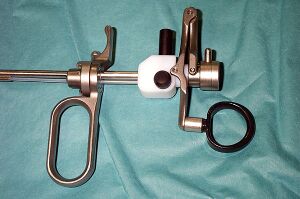Transurethral resection of the prostate
Transurethral resection of the prostate , or TURP, is the surgical method of choice used to treat benign prostatic hyperplasia (BPH). It comes next in patients for whom pharmacological treatment with α-blockers (alfuzosin , tamsulosin ), 5α-reductase inhibitors (finasteride , dutasteride ) or their combination is no longer sufficient. An alternative to the procedure is transvesical prostatectomy (non-radical), but it is burdened with greater postoperative morbidity. Another possibility is laser evaporation, but it has lower efficiency, more complications, and moreover, the possibility of histological determination of the tissue is eliminated.
Method Objectives[edit | edit source]
- Therapy - removal of infravesical obstruction (on the basis of BHP) that does not respond to pharmacological treatment - i.e. ensuring quality micturition and reduction of post micturition residue; palliative treatment for prostate cancer ; therapy of recurrent cystolithiasis or renal insufficiency.
- Diagnostics – histological verification of the diagnosis of BPH, cancer, prostatitis.
Execution[edit | edit source]
The procedure is usually performed under general anesthesia through the urethra under visual control (on a screen), when the prostate tissue is excised from the bladder neck to the colliculus seminalis with a resection loop (resectoscope, diameter usually 24-27 Ch ) . The depth of resection is up to the surgical capsule of the prostate, i.e. the entire transition zone, which is the source of BHP, is removed. The bottom of the resection area is then coagulated, which stops the bleeding. Finally, the bladder is washed of blood, coagulum and excised tissue, which is sent for histological determination. After the procedure, a permanent urinary catheter (PMK) is inserted, the balloon of which also tampons the resection area and thus reduces postoperative bleeding. The coil is usually left for 3 days, or until the bleeding stops.
- Before discharging the patient, a control ultrasound examination of the post-micturition residue in the bladder should be performed .
Possible complications[edit | edit source]
- Hematuria – the most common early complication , with PMK left, its disappearance usually occurs soon after the procedure. In the case of massive hematuria, bladder tamponade is possible (when flushing from coagulum is necessary), and in the case of a decrease in red blood cells, replacement with blood derivatives is also necessary.
- Urgency – usually after pulling out the PMK, takes antispasmodic therapy. It can also be a symptom of the aforementioned urinary tract infection.
- Urinary incontinence - after PMK extraction (permanent in less than 1% of operants , but it is the most serious problem socially).
- Perforation of the surgical capsule of the prostate – the solution is thorough coagulation of the scum and accelerated termination of the procedure.
- Urinary tract infection – we prevent it with a one-time preventive administration of ATB.
- Retrograde ejaculation (65-70%) – ejaculation into the bladder.
- Erectile dysfunction (2-3%).
- Urethral stricture – the most common late complication (4–28%) , usually develops within 6 months.
- Bladder neck stricture – mostly due to excessive coagulation in the neck.
- " TUR syndrome " (exceptionally) – consequences of hypervolemia from absorption of irrigation fluid by the resection base, increased bleeding with opening of venous plexuses is a risk factor.
- Embolism (pulmonary) – prevention is the administration of low-molecular-weight heparin before the procedure, or even in the postoperative period.
- Other non-urological complications (below 1% ) – deep vein thrombosis , myocardial infarction , central cerebrovascular events .
Prognosis[edit | edit source]
- The surgical results are excellent, micturition difficulties caused by obstruction in the area of the prostatic urethra disappear immediately.
- Within a few years, the remaining tissue of the transition zone may become thickened. The patient will have micturition difficulties again and the procedure must be repeated.
Links[edit | edit source]
Video[edit | edit source]
TURP – video recording (English)
Related Articles [ edit | edit source ][edit | edit source]
References [ edit | edit source ][edit | edit source]
- KAWACIUK, Ivan. Urology. 1st edition. Prague: Galén, c2009. ISBN 978-80-7262-627-7 .
References [ edit | edit source ][edit | edit source]
- ↑Jump up to:a b c d KAWACIUK, Ivan. Urology. 1st edition. Prague: Galén, c2009. ISBN 978-80-7262-627-7 .


